2007 SUBARU OUTBACK mirror
[x] Cancel search: mirrorPage 216 of 442
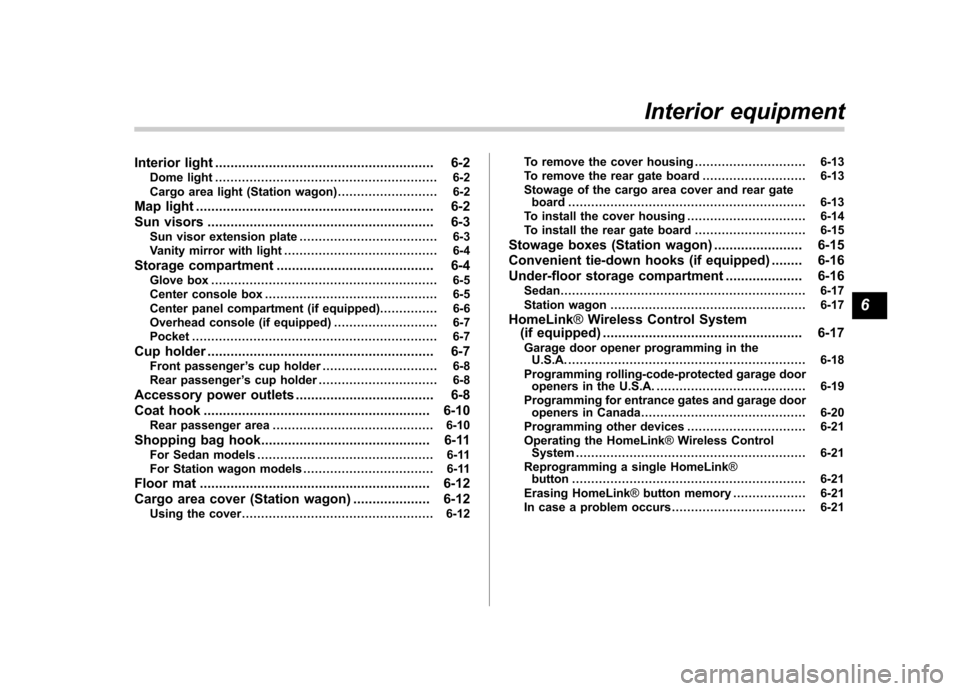
Interior light......................................................... 6-2
Dome light .......................................................... 6-2
Cargo area light (Station wagon) .......................... 6-2
Map light .............................................................. 6-2
Sun visors ........................................................... 6-3
Sun visor extension plate .................................... 6-3
Vanity mirror with light ........................................ 6-4
Storage compartment ......................................... 6-4
Glove box ........................................................... 6-5
Center console box ............................................. 6-5
Center panel compartment (if equipped)... ............ 6-6
Overhead console (if equipped) ........................... 6-7
Pocket ................................................................ 6-7
Cup holder ........................................................... 6-7
Front passenger ’s cup holder .............................. 6-8
Rear passenger ’s cup holder ............................... 6-8
Accessory power outlets .................................... 6-8
Coat hook ........................................................... 6-10
Rear passenger area .......................................... 6-10
Shopping bag hook ............................................ 6-11
For Sedan models .............................................. 6-11
For Station wagon models .................................. 6-11
Floor mat ............................................................ 6-12
Cargo area cover (Station wagon) .................... 6-12
Using the cover .................................................. 6-12 To remove the cover housing ...
.......................... 6-13
To remove the rear gate board . .......................... 6-13
Stowage of the cargo area cover and rear gate board .............................................................. 6-13
To install the cover housing ............................... 6-14
To install the rear gate board ... .......................... 6-15
Stowage boxes (Station wagon) ....................... 6-15
Convenient tie-down hooks (if equipped) ........ 6-16
Under-floor storage compartment .................... 6-16
Sedan ................................................................ 6-17
Station wagon ................................................... 6-17
HomeLink ®Wireless Control System
(if equipped) .................................................... 6-17
Garage door opener programming in the U.S.A. .............................................................. 6-18
Programming rolling-code-protected garage door openers in the U.S.A. ....................................... 6-19
Programming for entrance gates and garage door openers in Canada ........................................... 6-20
Programming other devices ............................... 6-21
Operating the HomeLink ®Wireless Control
System ............................................................ 6-21
Reprogramming a single HomeLink ®
button ............................................................. 6-21
Erasing HomeLink ®button memory ................... 6-21
In case a problem occurs ................................... 6-21
Interior equipment
6
Page 219 of 442

6-4Interior equipment
CAUTION
Do not pull out the extension plate
with the sun visor positioned over
the windshield. The extension plate
would obstruct your view of the
rearview mirror. &
Vanity mirror with light
CAUTION
Keep the vanity mirror cover closed
while the car is being driven to avoiddazzle.
To use the vanity mirror, swing down the
sun visor and open the vanity mirror cover.
The light beside the vanity mirror comes
on when the ignition switch is either in the“ ACC ”or “ON ”position and the mirror
cover is opened.
NOTE
Use of the vanity mirror light for a long
period of time while the engine is not
running can cause battery discharge. Storage compartment
CAUTION
. Always keep the storage com-
partment closed while driving to
reduce the risk of injury in the
event of sudden stops or anaccident.
. Do not store spray cans, contain-
ers with flammable or corrosive
liquids or any other dangerous
items in the storage compart-ment.
Page 246 of 442
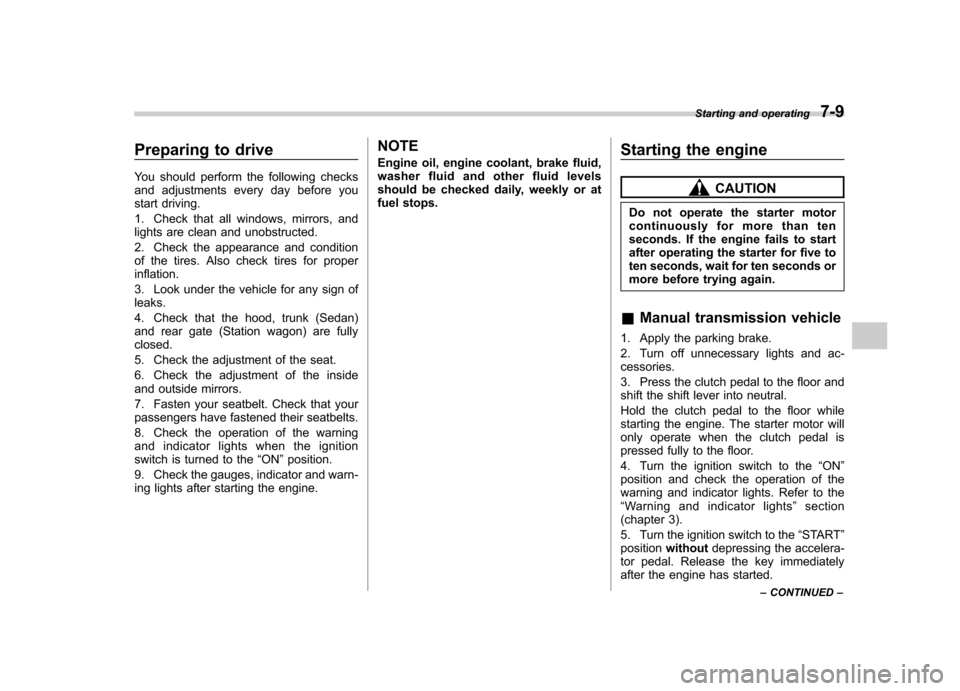
Preparing to drive
You should perform the following checks
and adjustments every day before you
start driving.
1. Check that all windows, mirrors, and
lights are clean and unobstructed.
2. Check the appearance and condition
of the tires. Also check tires for properinflation.
3. Look under the vehicle for any sign of leaks.
4. Check that the hood, trunk (Sedan)
and rear gate (Station wagon) are fullyclosed.
5. Check the adjustment of the seat.
6. Check the adjustment of the inside
and outside mirrors.
7. Fasten your seatbelt. Check that your
passengers have fastened their seatbelts.
8. Check the operation of the warning
and indicator lights when the ignition
switch is turned to the“ON ”position.
9. Check the gauges, indicator and warn-
ing lights after starting the engine. NOTE
Engine oil, engine coolant, brake fluid,
washer fluid and other fluid levels
should be checked daily, weekly or at
fuel stops.
Starting the engine
CAUTION
Do not operate the starter motor
continuously for more than ten
seconds. If the engine fails to start
after operating the starter for five to
ten seconds, wait for ten seconds or
more before trying again.
& Manual transmission vehicle
1. Apply the parking brake.
2. Turn off unnecessary lights and ac- cessories.
3. Press the clutch pedal to the floor and
shift the shift lever into neutral.
Hold the clutch pedal to the floor while
starting the engine. The starter motor will
only operate when the clutch pedal is
pressed fully to the floor.
4. Turn the ignition switch to the “ON ”
position and check the operation of the
warning and indicator lights. Refer to the“ Warning and indicator lights ”section
(chapter 3).
5. Turn the ignition switch to the “START ”
position without depressing the accelera-
tor pedal. Release the key immediately
after the engine has started. Starting and operating
7-9
– CONTINUED –
Page 314 of 442

chain connection, refer to the instructions
for your hitch and trailer. !Side mirrors
After hitching a trailer to your vehicle,
check that the standard side mirrors
provide a good rearward field of view
without significant blind spots. If significant
blind spots occur with the vehicle ’s stan-
dard side mirrors, use towing mirrors that
conform with Federal, state/province and/
or other applicable regulations. ! Trailer lights
CAUTION
Direct splicing or other improper
connection of trailer lights may
damage your vehicle ’s electrical system and cause a malfunction of
your vehicle
’s lighting system.
Connection of trailer lights to your vehi-cle ’s electrical system requires modifica-
tions to the vehicle ’s lighting circuit to
increase its capacity and accommodate
wiring changes. To ensure the trailer lights
are connected properly, please consult
your SUBARU dealer. Check for proper
operation of the turn signals, the brake
lights and parking lights each time you
hitch up. ! Tires
WARNING
Never tow a trailer when the tem-
porary spare tire is used. The tem-
porary spare tire is not designed to
sustain the towing load. Use of the
temporary spare tire when towing
can result in failure of the spare tire
and/or less stability of the vehicle.
Make sure that all the tires on your vehicle
are properly inflated.
The recommended cold tire pressure
under trailer towing conditions is shown
in chapter 12, “Specifications ”and in
“ GAS STATION REFERENCE ”at the end of this manual. Adjust the rear tire
pressure to the recommended pressure
when the tires are cold. Normal pressure
should be maintained in the front tires.
Trailer tire condition, size, load rating and
proper inflation pressure should be in
accordance with the trailer manufacturer
’s
specifications.
In the event your vehicle gets a flat tire
when towing a trailer, ask a commercial
road service to repair the flat tire.
If you carry a regular size spare tire in your
vehicle or trailer as a precaution against
getting a flat tire, be sure that the spare
tire is firmly secured.
& Trailer towing tips
CAUTION
. Never exceed 45 mph (72 km/h)
when towing a trailer in hilly
country on hot days.
. When towing a trailer, steering,
stability, stopping distance and
braking performance will be dif-
ferent from normal operation. Forsafety ’s sake, you should employ
extra caution when towing a
trailer and you should never Driving tips
8-27
– CONTINUED –
Page 315 of 442
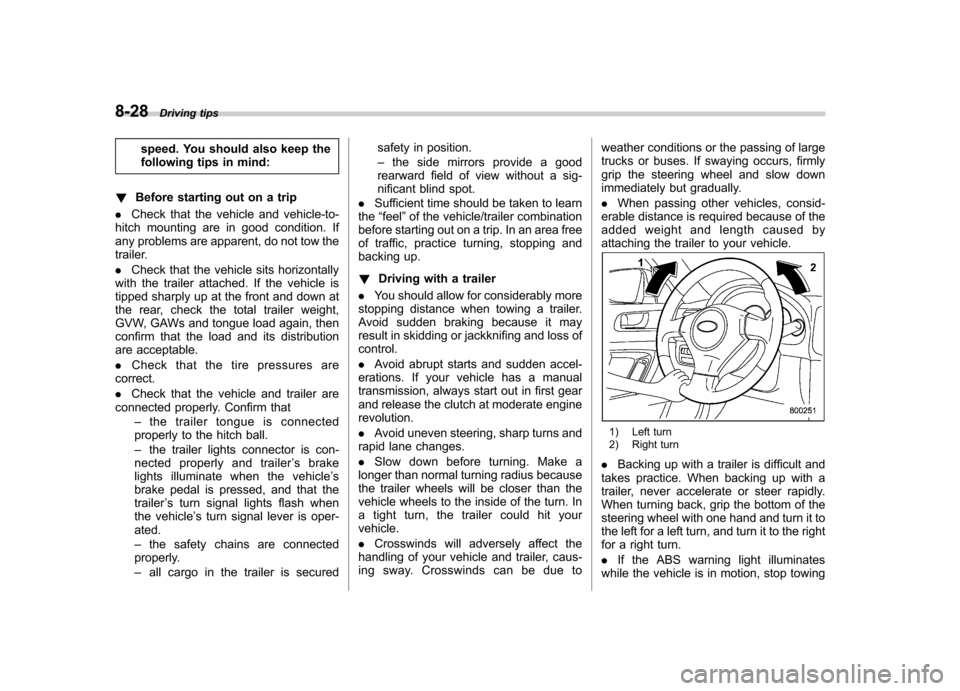
8-28Driving tips
speed. You should also keep the
following tips in mind:
! Before starting out on a trip
. Check that the vehicle and vehicle-to-
hitch mounting are in good condition. If
any problems are apparent, do not tow the
trailer. . Check that the vehicle sits horizontally
with the trailer attached. If the vehicle is
tipped sharply up at the front and down at
the rear, check the total trailer weight,
GVW, GAWs and tongue load again, then
confirm that the load and its distribution
are acceptable. . Check that the tire pressures are
correct.. Check that the vehicle and trailer are
connected properly. Confirm that
–the trailer tongue is connected
properly to the hitch ball. – the trailer lights connector is con-
nected properly and trailer ’s brake
lights illuminate when the vehicle ’s
brake pedal is pressed, and that the trailer ’s turn signal lights flash when
the vehicle ’s turn signal lever is oper-
ated. – the safety chains are connected
properly.– all cargo in the trailer is secured safety in position.–
the side mirrors provide a good
rearward field of view without a sig-
nificant blind spot.
. Sufficient time should be taken to learn
the “feel ”of the vehicle/trailer combination
before starting out on a trip. In an area free
of traffic, practice turning, stopping and
backing up. ! Driving with a trailer
. You should allow for considerably more
stopping distance when towing a trailer.
Avoid sudden braking because it may
result in skidding or jackknifing and loss ofcontrol. . Avoid abrupt starts and sudden accel-
erations. If your vehicle has a manual
transmission, always start out in first gear
and release the clutch at moderate enginerevolution. . Avoid uneven steering, sharp turns and
rapid lane changes. . Slow down before turning. Make a
longer than normal turning radius because
the trailer wheels will be closer than the
vehicle wheels to the inside of the turn. In
a tight turn, the trailer could hit yourvehicle. . Crosswinds will adversely affect the
handling of your vehicle and trailer, caus-
ing sway. Crosswinds can be due to weather conditions or the passing of large
trucks or buses. If swaying occurs, firmly
grip the steering wheel and slow down
immediately but gradually. .
When passing other vehicles, consid-
erable distance is required because of the
added weight and length caused by
attaching the trailer to your vehicle.
1) Left turn
2) Right turn
. Backing up with a trailer is difficult and
takes practice. When backing up with a
trailer, never accelerate or steer rapidly.
When turning back, grip the bottom of the
steering wheel with one hand and turn it to
the left for a left turn, and turn it to the right
for a right turn. . If the ABS warning light illuminates
while the vehicle is in motion, stop towing
Page 409 of 442

12-6Specifications
Fuses and circuits &Fuse panel located in the passenger compartmentFuse
panel Fuse
rating Circuit
1 20A .Cargo fan
. Trailer hitch connector
2 Empty
3 15A .Door locking
4 15A .Front wiper deicer relay
. Moonroof
5 15A .Combination meter
6 7.5A .Remote control rear
view mirrors
. Seat heater relay
. Vanity mirror light
7 15A .Combination meter
. Integrated unit
8 20A .Stop light
9 20A .Mirror heater
. Front wiper deicer
10 7.5A .Power supply (Battery)
11 7.5A .Turn signal unit
. Clock
12 15A .Automatic transmission
unit
. SRS airbag system
(Sub)
. Engine control unit
. Integrated unit
Page 431 of 442
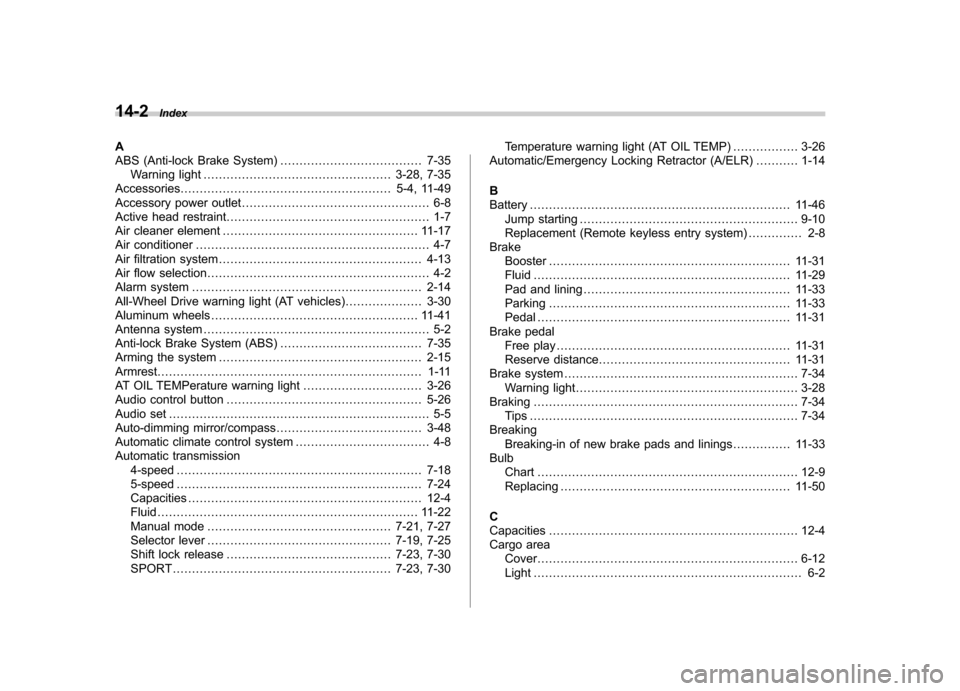
14-2Index
A
ABS (Anti-lock Brake System) ..................................... 7-35
Warning light ................................................. 3-28, 7-35
Accessories ....................................................... 5-4, 11-49
Accessory power outlet ................................................. 6-8
Active head restraint ..................................................... 1-7
Air cleaner element ................................................... 11-17
Air conditioner ............................................................. 4-7
Air filtration system ..................................................... 4-13
Air flow selection .......................................................... 4-2
Alarm system ............................................................ 2-14
All-Wheel Drive warning light (AT vehicles) .................... 3-30
Aluminum wheels ...................................................... 11-41
Antenna system ........................................................... 5-2
Anti-lock Brake System (ABS) ..................................... 7-35
Arming the system ..................................................... 2-15
Armrest ..................................................................... 1-11
AT OIL TEMPerature warning light ............................... 3-26
Audio control button ................................................... 5-26
Audio set .................................................................... 5-5
Auto-dimming mirror/compass ...................................... 3-48
Automatic climate control system ................................... 4-8
Automatic transmission 4-speed ................................................................ 7-18
5-speed ................................................................ 7-24
Capacities ............................................................. 12-4
Fluid .................................................................... 11-22
Manual mode ................................................ 7-21, 7-27
Selector lever ................................................ 7-19, 7-25
Shift lock release ........................................... 7-23, 7-30
SPORT ......................................................... 7-23, 7-30 Temperature warning light (AT OIL TEMP)
................. 3-26
Automatic/Emergency Locking Retractor (A/ELR) ........... 1-14
BBattery .................................................................... 11-46
Jump starting ......................................................... 9-10
Replacement (Remote keyless entry system) .............. 2-8
Brake
Booster ............................................................... 11-31
Fluid ................................................................... 11-29
Pad and lining ...................................................... 11-33
Parking ............................................................... 11-33
Pedal .................................................................. 11-31
Brake pedal
Free play ............................................................. 11-31
Reserve distance .................................................. 11-31
Brake system ............................................................. 7-34
Warning light .......................................................... 3-28
Braking ..................................................................... 7-34
Tips ...................................................................... 7-34
Breaking
Breaking-in of new brake pads and linings ............... 11-33
Bulb Chart .................................................................... 12-9
Replacing ............................................................ 11-50
CCapacities ................................................................. 12-4
Cargo area Cover .................................................................... 6-12
Light ...................................................................... 6-2
Page 434 of 442
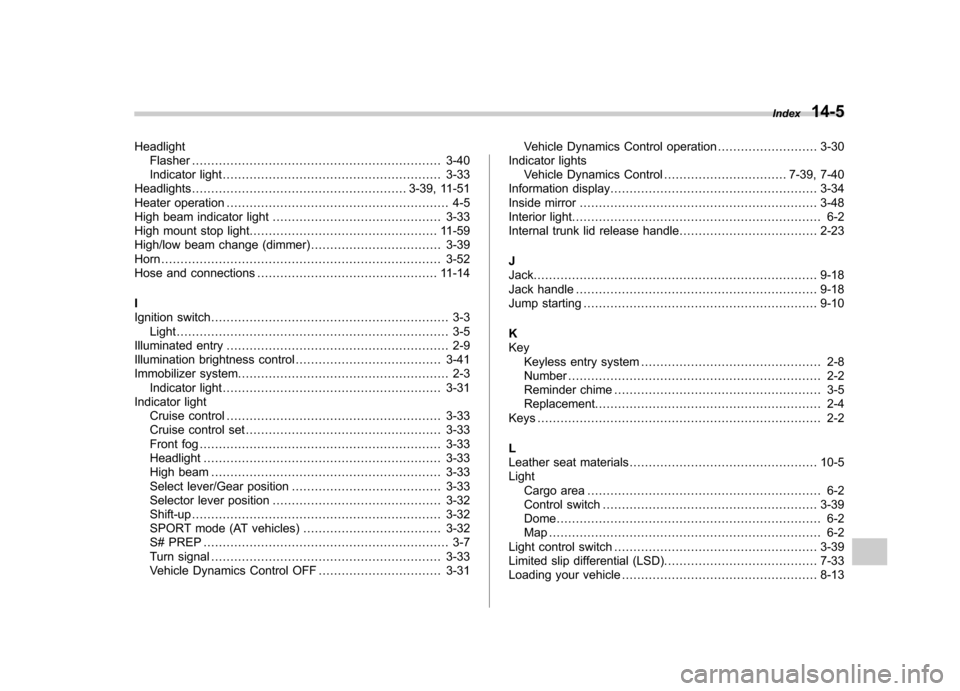
HeadlightFlasher ................................................................. 3-40
Indicator light ......................................................... 3-33
Headlights ........................................................ 3-39, 11-51
Heater operation .......................................................... 4-5
High beam indicator light ............................................ 3-33
High mount stop light ................................................. 11-59
High/low beam change (dimmer) .................................. 3-39
Horn ......................................................................... 3-52
Hose and connections ............................................... 11-14
I
Ignition switch .............................................................. 3-3
Light ....................................................................... 3-5
Illuminated entry .......................................................... 2-9
Illumination brightness control ...................................... 3-41
Immobilizer system. ...................................................... 2-3
Indicator light ......................................................... 3-31
Indicator light
Cruise control ........................................................ 3-33
Cruise control set ................................................... 3-33
Front fog ............................................................... 3-33
Headlight .............................................................. 3-33
High beam ............................................................ 3-33
Select lever/Gear position ....................................... 3-33
Selector lever position ............................................ 3-32
Shift-up ................................................................. 3-32
SPORT mode (AT vehicles) .................................... 3-32
S# PREP ................................................................ 3-7
Turn signal ............................................................ 3-33
Vehicle Dynamics Control OFF ................................ 3-31 Vehicle Dynamics Control operation
.......................... 3-30
Indicator lights
Vehicle Dynamics Control ................................ 7-39, 7-40
Information display ...................................................... 3-34
Inside mirror .............................................................. 3-48
Interior light ................................................................. 6-2
Internal trunk lid release handle .................................... 2-23
JJack. ......................................................................... 9-18
Jack handle ............................................................... 9-18
Jump starting ............................................................. 9-10
KKey Keyless entry system ............................................... 2-8
Number .................................................................. 2-2
Reminder chime ...................................................... 3-5
Replacement. .......................................................... 2-4
Keys .......................................................................... 2-2
L
Leather seat materials ................................................. 10-5
Light
Cargo area ............................................................. 6-2
Control switch ........................................................ 3-39
Dome ..................................................................... 6-2
Map ....................................................................... 6-2
Light control switch ..................................................... 3-39
Limited slip differential (LSD). ....................................... 7-33
Loading your vehicle ................................................... 8-13 Index
14-5